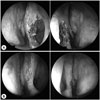Abstract
IgG4-related sclerosing disease was first discovered when researching autoimmune pancreatitis. It is an autoimmune disease that causes fibrosis on the pancreas, bile duct, gall bladder, salivary glands, and lungs. It is rarely reported in the nasal cavity. The diagnosis of IgG4-related sclerosing disease is based on biopsy findings demonstrating the characteristic histopathologic findings and immunohistochemical staining. IgG4-related sclerosing disease shows good response to high-dose steroid therapy. However, some patients do not respond to this treatment. Azathioprine or rituximab can be helpful in such case. We report our experience with IgG4-related sclerosing disease treated with azathioprine for 2 years, along with a related literature review.
Figures and Tables
 | Fig. 1Endoscopic findings of nasal cavity (2014.11.13). A: Large sized perforation (arrow) with very thin mucosal membrane and severe inflammation in right nasal cavity after crust removal. B: Left Nasal cavity before crust removal. White material is a Merocel packing to protect blood aspiration during deep biopsy. C: Ulcerative lesion (arrow) around left lateral nasal wall. U: Uncinate process, M: Middle turbinate, S: Septum. |
 | Fig. 2Radiologic findings. CT image showing mucosal thickening of left maxillary sinus, Coronal view (A). Axial view (B). Coronal MR image showing mucosal thickening of supero-anterior portion of left lateral nasal wall with left maxillary mucosal thickening, T1-weighted image (C). T1-weighted with gadolinium enhancement (D). T2-weighted image (E). |
 | Fig. 3Pathologic findings. It reveals fibrosclerotic change with marked lymphoplasmacytic inflammation (H&E, ×400) (A). It shows large Immunoglobulin G4 (IgG4)-positive plasma cell in fibrosclerotic stroma, measuring 35/HPF and the ratio of IgG4 with IgG is about 40% (IgG4 immunoperoxidase stain, ×400) (B). |
References
1. Umehara H, Okazaki K, Masaki Y, Kawano M, Yamamoto M, Saeki T, et al. Comprehensive diagnostic criteria for IgG4-related disease (IgG4-RD), 2011. Mod Rheumatol. 2012; 22(1):21–30.

2. Chen Y, Zhao JZ, Feng RE, Shi JH, Li XM, Fei YY, et al. Types of Organ Involvement in Patients with Immunoglobulin G4-related Disease. Chin Med J (Engl). 2016; 129(13):1525–1532.

3. Zen Y, Fujii T, Harada K, Kawano M, Yamada K, Takahira M, et al. Th2 and regulatory immune reactions are increased in immunoglobin G4-related sclerosing pancreatitis and cholangitis. Hepatology. 2007; 45(6):1538–1546.

4. Ishida M, Hotta M, Kushima R, Shibayama M, Shimizu T, Okabe H. Multiple IgG4-related sclerosing lesions in the maxillary sinus, parotid gland and nasal septum. Pathol Int. 2009; 59(9):670–675.

5. Sasaki T, Takahashi K, Mineta M, Fujita T, Aburano T. Immunoglobulin G4-Related Sclerosing Disease Mimicking Invasive Tumor in the Nasal Cavity and Paranasal Sinuses. AJNR Am J neuroradiol. 2012; 33(2):E19–E20.

6. Lee KK, Cho HP, Lee YM, Park JH. A case of immunoglobulin G4-related sialadenitis and dacryoadenitis. Korean J Otorhinolaryngol-Head Neck Surg. 2013; 56(7):444–447.

7. Yoon HJ, Park WS, Ji YB, Lee SH. Two Cases of Immunoglobulin G4-Related Sclerosing Disease Mimicking Nasopharyngeal Carcinoma. Korean J Otorhinolaryngol-Head Neck Surg. 2016; 59(4):304–308.

8. Suzuki M, Nakamaru Y, Akazawa S, Mizumachi T, Maeda M, Takagi D, et al. Nasal manifestations of immunoglobulin G4-related disease. Laryngoscope. 2013; 123(4):829–834.

9. Okazaki K, Uchida K, Miyoshi H, Ikeura T, Takaoka M, Nishio A. Recent concepts of autoimmune pancreatitis and IgG4-related disease. Clin Rev Allergy Immunol. 2011; 41(2):126–138.

10. Ikeda R, Awataguchi T, Shoji F, Oshima T. A case of paranasal sinus lesions in IgG4-related sclerosing disease. Otolaryngol Head Neck Surg. 2010; 142(3):458–459.

11. Pace C, Ward S. A rare case of IgG4-related sclerosing disease of the maxillary sinus associated with bone destruction. J Oral Maxillofac Surg. 2010; 68(10):2591–2593.

12. Lee JR, Lee BJ, Chung YS. Three Cases of IgG4-Related Sclerosing Disease in Nasal Cavity. J Rhinol. 2016; 23(1):44–48.

13. Kitagawa S, Zen Y, Harada K, Sasaki M, Sato Y, Minato H, et al. Abundant IgG4-positive plasma cell infiltration characterizes chronic sclerosing sialadenitis (Küttner's tumor). Am J Surg Pathol. 2005; 29(6):783–791.





 PDF
PDF ePub
ePub Citation
Citation Print
Print




 XML Download
XML Download